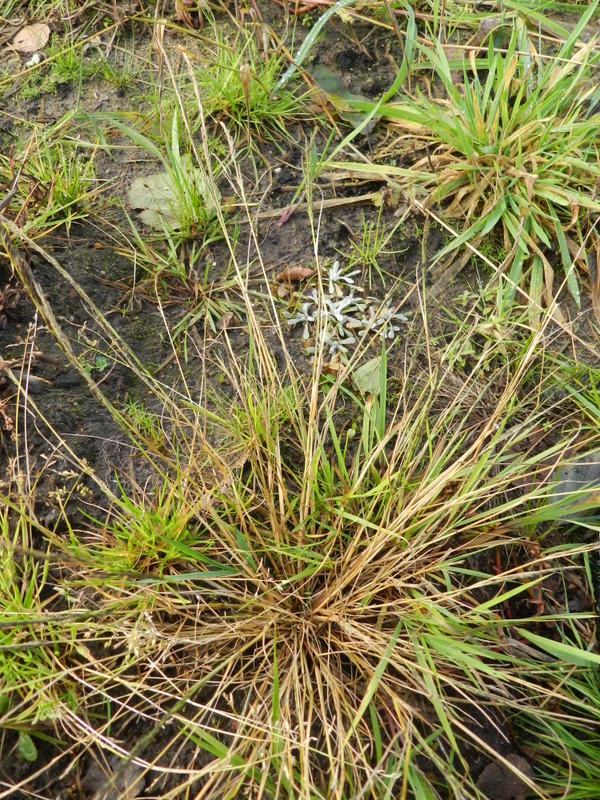Eragrostis pilosa
7. Eragrostis pilosa (L.) Beauv. (Euras., N-Afr.) – A very rare and ephemeral alien. Probably first collected by a railway track in Genappes in 1877. Furthermore occasionally found as a wool alien in the Vesdre valley near Verviers, at least between 1904 and 1950. Exceptionally seen elsewhere, for instance in the port of Antwerpen in 1901. In the past decades very rarely seen and probably mostly associated with grain importation (for instance in Roeselare in 1992 and 1995). In 2013 also seen on rough ground near a plant nursery in Mol.
Eragrostis pilosa is here accepted in a narrow sense, excluding E. multicaulis (see also there). In Belgium both species are distinguished without difficulty: in Eragrostis pilosa the lowermost inflorescence branches are always verticillate (vs. single) and the periligular zone always bears some hairs (vs. glabrous). Inflorescences also appear to be quite different: in Eragrostis pilosa the inflorescence branches long remain erect (inflorescence long and slender) whereas they are soon patent in E. multicaulis (inflorescence pyramidal) (see also herbarium scans for both species).
Eragrostis pilosa itself belongs to a very complex and insufficiently understood species group (Koch 1974). Several infraspecific taxa have been described in the past, see for instance Scholz (1988). A recently described subspecies from river Dordogne in France, subsp. felzinesii Portal (Portal 2002), is obviously more closely related to Eragrostis pectinacea than it is to E. pilosa, especially with regard to glume characters. A closer examination revealed that it is identical with Eragrostis pectinacea var. miserrima (E. Fourn.) Reeder (syn.: E. tephrosanthos Schult., E. pectinacea subsp. felzinesii (Portal) Scholz) (Scholz 2008). This taxon is also known from northern Italy (Wilhalm & al. 2002) and should be looked for elsewhere in Europe.
 |
 |
 |
 |
Selected literature:
Hohla M. (2006) Neues über die Verbreitung von Eragrostis albensis, E. multicaulis und E. pilosa in Österreich. Linzer biol. Beitr. 38(2): 1233-1253.
Hügin G. (1999) Anmerkungen zur Unterscheidung von Eragrostis multicaulis und Eragrostis pilosa. Botanik und Naturschutz in Hessen 11: 91-93.
Jung K.-D. (2007) Anmerkungen zu Eragrostis "pilosa" in Darmstadt. Hess. Florist. Briefe 56: 60-61.
Koch S.D. (1974) The Eragrostis pectinacea-pilosa complex in North and Central America. Illinois Biol. Monogr. 48: 1-74.
Nobis M. & Nobis A. (2009) Eragrostis pilosa (L.) P. Beauv. (Poaceae) in Poland. Biodiversity: Research and Conservation 13: 13-16. [available online at: http://www.brc.amu.edu.pl/s2_c6_abstract119.html]
Portal R. (2002) Eragrostis pilosa subsp. felzinesii et Eragrostis virescens subsp. verloovei (Poaceae: Chloridoideae, Eragrostideae) deux nouvelles sous-espèces pour l'Europe. Bull. Soc. Bot. Centre-Ouest N.S. 33: 3-8.
Röthlisberger J. (1999) Eragrostis pilosa (L.) P. B. (Poaceae) in der Schweiz: Geschichte einer Wiedereroberung? Courier Forschungsinstitut Senckenberg 215: 171-176.
Scholz H. (1988) Zwei neue Taxa des Eragrostis pilosa-Komplexes (Poaceae). Willdenowia 18: 217-222.
Scholz H. (2008) Eragrostis pectinacea subsp. felzinesii (Portal) H. Scholz. In: Greuter W. & Raus T. (eds.), Med-Checklist Notulae, 27. Willdenowia 38: 471. [available online at: http://www.geobotanik.org/bergmeier/dokumente/Willdenowia%2038-2MChNot%2027.pdf]
Scholz H. & Ristow M. (2005) Neue Nachrichten über die Gattung Eragrostis (Gramineae) in Mitteleuropa. Verh. Bot. Ver. Berlin Brandenburg 138: 15-29.
Sudnik Wojcikowska B. & Guzik J. (1996) The spread and habitats of Eragrostis pilosa (Poaceae) in the Vistula valley. Fragm. Flor. Geobot. 41(2): 753-769.
Van Ooststroom S.J. & Reichgelt Th.J. (1966) Aanwinsten voor de Nederlandse adventief-flora, 9. Gorteria 3: 51-59.
Wattendorff J. (2002) Das Behaarte Liebesgras, Eragrostis pilosa (L.) P. B., neu in Stadt und Kanton Freiburg (Schweiz). Bull. Soc. Fribourg. Sc. Nat. 91: 125-128.
Wilhalm T., Stockner W. & Tratter W. (2002) Für die Flora Südtirols neue Gefässpflanzen. Gredleriana 2: 295-318. [available online at: http://www.landesmuseum.at/pdf_frei_remote/Gredleriana_002_0295-0318.pdf]

